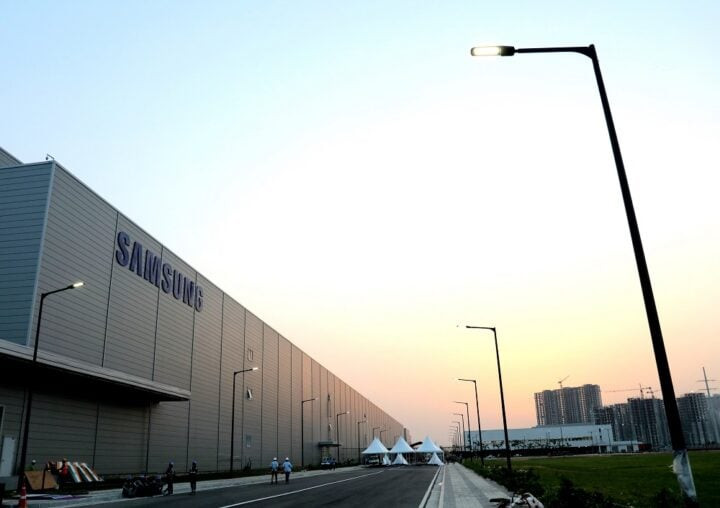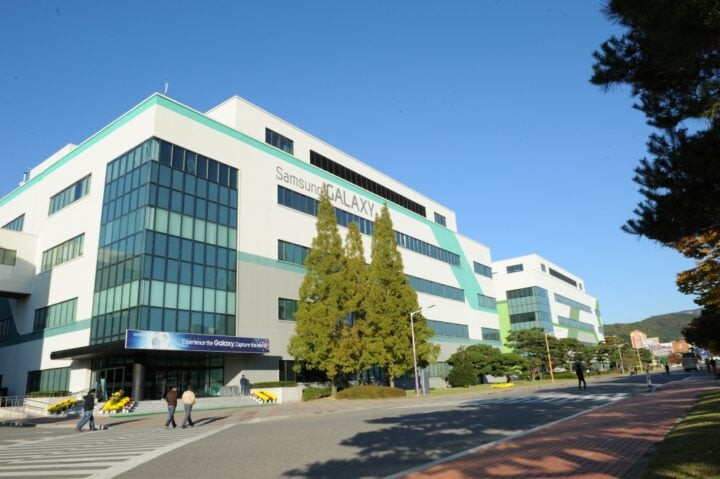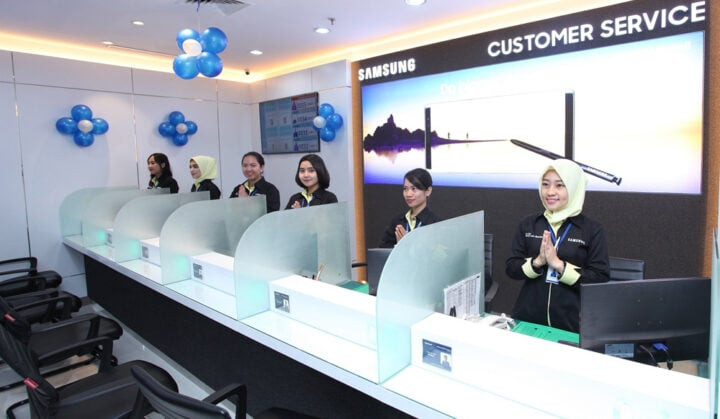Samsung stands as a titan in the smartphone industry, consistently holding the top vendor position worldwide. To meet the demand for hundreds of millions of devices annually, Samsung operates a vast and intricate manufacturing ecosystem across the globe. While the question of where Samsung phones are made is frequently asked, understanding the nuances of their global production is key to appreciating the brand’s scale and commitment to quality.
Vietnam: A Major Manufacturing Powerhouse for Samsung
Samsung manufacturing complex in Thai Nguyen province, Vietnam, a primary location for producing Galaxy smartphones, tablets, and wearables for global distribution.
Contrary to what some might assume, China is not the primary manufacturing location for Samsung smartphones anymore. Although China is often considered the world’s manufacturing hub and a key production site for many tech companies, including Apple, Samsung has significantly shifted its manufacturing strategy in recent years. Instead, Vietnam has emerged as the leading country where Samsung manufactures a significant portion of its Galaxy phones and other devices.
Samsung’s extensive manufacturing facilities in Vietnam, located in the Thai Nguyen province, are pivotal to its global operations. These facilities consist of multiple factories dedicated to producing a wide array of Samsung products, including smartphones, tablets, and wearable devices. In fact, the scale of production in Vietnam is immense, with existing factories capable of churning out approximately 120 million units each year. To further bolster its production capacity, Samsung is actively expanding its Vietnamese operations by adding new factories to the complex. A substantial portion of Samsung’s global supply, reaching markets as far-reaching as North America and Europe, originates from these Vietnamese factories.
India: Home to Samsung’s Largest Mobile Factory

Samsung’s Noida, India factory, the world’s largest mobile phone manufacturing facility by production capacity, producing Galaxy smartphones for the local market and potential export.
India holds a unique position in Samsung’s global manufacturing network. Not only does India house Samsung’s largest mobile factory, but it also boasts the title of the largest mobile phone manufacturing unit globally based on production capacity. This massive facility, located in Noida, Uttar Pradesh, is a testament to Samsung’s commitment to the Indian market and its strategic importance.
Samsung significantly invested in its Indian manufacturing capabilities, announcing a substantial $620 million investment in 2017 to double smartphone production in the country. This investment culminated in the inauguration of the expanded Noida factory in 2018, which now possesses an impressive production capacity of 120 million units per year. While a significant portion of the output from the Indian factory is intended to cater to the booming domestic market, Samsung also leverages this facility to potentially export smartphones to other regions, including Europe, Africa, and West Asia. Local production in India is crucial for Samsung to remain competitive in this price-sensitive market, especially considering import taxes, allowing them to effectively compete with rivals. The factory primarily manufactures Galaxy M and Galaxy A series handsets, popular in the Indian market.
South Korea: The Foundation and Core Component Hub

Samsung’s Gumi Campus in South Korea, a key manufacturing location for domestic market devices and a central hub for component sourcing from sister companies.
Samsung maintains a manufacturing presence in its home country of South Korea, which remains a strategically important location for several reasons. South Korea serves as a crucial hub for component sourcing, particularly for parts obtained from Samsung’s affiliated companies within the larger Samsung Group. These components are then utilized in manufacturing facilities across the globe.
However, in terms of smartphone production volume, the South Korean factories account for a smaller percentage of Samsung’s global shipments, less than 10 percent. The smartphones manufactured in South Korea are primarily designated for the domestic market. Despite the lower volume compared to other locations, South Korea’s manufacturing operations are vital for research and development, high-end production, and maintaining close ties to its component supply chain.
Brazil: Serving the Latin American Market
Samsung’s manufacturing plant in Brazil, established in 1999, employing over 6,000 workers to produce smartphones for distribution throughout Latin America.
Samsung’s manufacturing footprint extends to Latin America with a significant facility in Brazil. Established in 1999, this factory plays a crucial role in supplying Samsung smartphones to the entire Latin American region. Employing over 6,000 workers, the Brazilian factory enables Samsung to efficiently serve this vast market.
Similar to India, Brazil’s high import taxes make local production a strategic imperative for Samsung. Manufacturing within Brazil allows Samsung to offer its products at competitive prices within the country and across Latin America, ensuring market access and affordability for consumers in the region.
Indonesia: Meeting Local Demand in Southeast Asia

Samsung’s factory in Indonesia, opened in 2015, producing smartphones to meet local market demands and strengthen its position in Southeast Asia.
Indonesia is another country in Southeast Asia where Samsung manufactures its smartphones. Samsung’s decision to establish a manufacturing presence in Indonesia is relatively recent, with the factory opening its doors in 2015. This facility, while smaller in scale compared to Vietnam or India, has a production capacity of approximately 800,000 units per year.
The primary purpose of the Indonesian factory is to cater to the local demand within Indonesia’s market. By manufacturing locally, Samsung can efficiently and effectively meet the needs of Indonesian consumers and strengthen its market position in this important Southeast Asian nation.
China: Shifting Manufacturing Strategies
Historically, China was a significant manufacturing location for Samsung. However, Samsung has strategically adjusted its manufacturing priorities over the past decade, leading to a change in its Chinese operations. Notably, Samsung closed its last remaining smartphone factory in China in 2019. This closure marked a significant shift, as Samsung no longer manufactures smartphones in mainland China.
This decision was driven by a substantial decrease in Samsung’s market share in China, falling below 1%. As Chinese smartphone OEMs gained dominance in their domestic market, it became less financially viable for Samsung to maintain large-scale production in the country. While Samsung previously operated two factories in China, the declining market share necessitated a scaling back of production, ultimately leading to the cessation of smartphone manufacturing in China.
The Rise of ODM: A New Manufacturing Model
The global smartphone market has undergone significant transformations, with increased competition from Chinese manufacturers across all market segments. To adapt to these evolving market dynamics and enhance competitiveness, Samsung has embraced new manufacturing models, including Original Design Manufacturing (ODM).
In 2019, Samsung released its first ODM smartphone, the Galaxy A6s, initially for the Chinese market. In the ODM model, Samsung partners with third-party manufacturers to produce devices based on Samsung’s designs and specifications. This approach allows Samsung to improve cost efficiency, particularly for more affordable devices, by leveraging the manufacturing expertise and cost structures of ODM partners. Industry projections indicate a significant increase in Samsung’s ODM smartphone shipments in the near future, potentially reaching 60 million units, expanding beyond the Chinese market to global distribution. This shift towards ODM reflects Samsung’s strategic adjustments to optimize its manufacturing footprint and maintain competitiveness in a dynamic global market.
“Original” Samsung Phones: Debunking Manufacturing Myths
Misconceptions often arise regarding the “originality” or quality of Samsung phones based on their country of manufacture. However, it’s essential to understand that Samsung maintains stringent quality standards across all its manufacturing facilities and ODM partners globally.
Whether a Samsung phone is manufactured in Vietnam, India, South Korea, Brazil, Indonesia, or by an ODM partner, it is considered an “original” Samsung product. These factories operate primarily as assembly plants, receiving components from the same global supply chain and adhering to identical manufacturing and quality control processes dictated by Samsung. Therefore, the country of origin does not inherently dictate the quality or authenticity of a Samsung phone. Concerns about “originality” based on manufacturing location are largely unfounded. The key differentiator is purchasing from authorized retailers to avoid counterfeit products, which are a separate issue altogether and easily identifiable by obvious signs like misspellings or poor build quality.
In conclusion, Samsung’s global manufacturing network is a complex and strategically designed ecosystem. While Vietnam currently stands out as a major production hub, Samsung leverages facilities across India, South Korea, Brazil, and Indonesia to serve diverse regional markets and optimize its global supply chain. Regardless of where your Samsung phone is made, rest assured that it adheres to the company’s rigorous quality standards, ensuring a consistent and reliable user experience worldwide.
